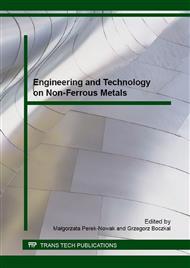p.177
p.182
p.189
p.199
p.205
p.212
p.220
p.226
p.239
Influence of Continuous Casting Conditions on Segregation of Additions in EN AW 1350 Aluminum Alloy
Abstract:
Integrated continuous casting processes are an important element of the production process in modern industry. Requirements for quality and exploitation properties of products obtained using continuous casting processes necessitate a revision of the role of impurities distribution in the material. This paper concerns on the influence of the casting process on the distribution of alloy additions. Spectroscopy studies were performed for the most sensitive elements, from the segregation, (i.e. : iron and silicon) point of view. Next obtained research results were correlated with the parameters of chemical composition such as casting speed, the presence of a modifier and the processing of metal crystallization zone. Analysis of the results clearly shows the presence of iron and silicon normal macrosegregation. It was observed that the concentration of these elements is highest in the casting axis and, in the case of iron, is 50% higher in the axis than in the circumference of casts.
Info:
Periodical:
Pages:
205-211
Citation:
Online since:
February 2016
Keywords:
Price:
Сopyright:
© 2016 Trans Tech Publications Ltd. All Rights Reserved
Share:
Citation:


